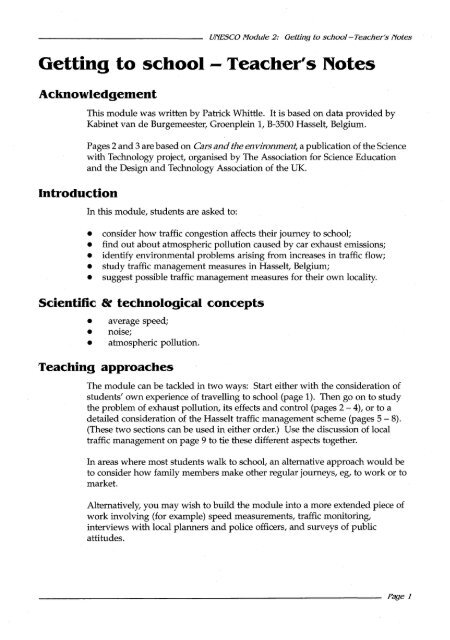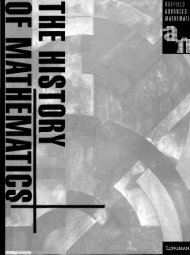UNESCO resource kit - science and technology educa...
UNESCO resource kit - science and technology educa...
UNESCO resource kit - science and technology educa...
You also want an ePaper? Increase the reach of your titles
YUMPU automatically turns print PDFs into web optimized ePapers that Google loves.
<strong>UNESCO</strong>Module 2: Oetting to school-Teachers Notes<br />
Getting to school - Teacher's Notes<br />
Acknowledgement<br />
Introduction<br />
This module was written by Patrick Whittle. It is based on data provided by<br />
Kabinet van de Burgemeester, Groenplein I, B-3500 Hasselt, Belgium.<br />
Pages 2 <strong>and</strong> 3 are based on Cars <strong>and</strong> the environment, a publication of the Science<br />
with Technology project, organised by The Association for Science Education<br />
<strong>and</strong> the Design <strong>and</strong> Technology Association of the UK.<br />
In this module, students are asked to:<br />
• consider how traffic congestion affects their journey to school;<br />
• find out about atmospheric pollution caused by car exhaust emissions;<br />
• identify environmental problems arising from increases in traffic flow;<br />
• study traffic management measures in Hasselt, Belgium;<br />
• suggest possible traffic management measures for their own locality.<br />
Scientific 8t. technological concepts<br />
• average speed;<br />
• noise;<br />
• atmospheric pollution.<br />
Teaching approaches<br />
The module can be tackled in two ways: Start either with the consideration of<br />
students' own experience of travelling to school (page 1). Then go on to study<br />
the problem of exhaust pollution, its effects <strong>and</strong> control (pages 2 - 4), or to a<br />
detailed consideration of the Hasselt traffic management scheme (pages 5 - 8).<br />
(These two sections can be used in either order.) Use the discussion of local<br />
traffic management on page 9 to tie these different aspects together.<br />
In areas where most students walk to school, an alternative approach would be<br />
to consider how family members make other regular journeys, eg, to work or to<br />
market.<br />
Alternatively, you may wish to build the module into a more extended piece of<br />
work involving (for example) speed measurements, traffic monitoring,<br />
interviews with local planners <strong>and</strong> police officers, <strong>and</strong> surveys of public<br />
attitudes.<br />
Page 1

















